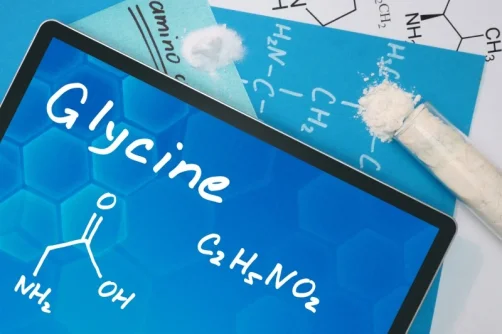Vince
Super Moderator
Glycine as a sweetener?
Blood glucose is not increased by glycine consumption, it contains zero fat or carbohydrates.
Date: December 2002 (Received August 22, 2001; Accepted January 24, 2002)
Key Researchers: Mary C Gannon, Jennifer A Nuttall, and Frank Q Nuttall (Metabolic Research Laboratory and Section of Endocrinology, Metabolism, and Nutrition, Minneapolis VA Medical Center, and Departments of Medicine and Food Science and Nutrition, University of Minnesota, Minneapolis)

Source:
metabolic response to ingested glycine
Blood glucose is not increased by glycine consumption, it contains zero fat or carbohydrates.
The Metabolic Response to Ingested Glycine
Source: Gannon, M. C., Nuttall, J. A., & Nuttall, F. Q. (2002). The metabolic response to ingested glycine. American Journal of Clinical Nutrition, 76(6), 1302–7.Date: December 2002 (Received August 22, 2001; Accepted January 24, 2002)
Key Researchers: Mary C Gannon, Jennifer A Nuttall, and Frank Q Nuttall (Metabolic Research Laboratory and Section of Endocrinology, Metabolism, and Nutrition, Minneapolis VA Medical Center, and Departments of Medicine and Food Science and Nutrition, University of Minnesota, Minneapolis)
1. Executive Summary
This study investigated the metabolic effects of oral glycine in healthy subjects, particularly its impact on glucose, insulin, and glucagon concentrations when ingested alone or with glucose. The findings demonstrate that oral glycine significantly attenuates the plasma glucose response when co-ingested with glucose, reducing the integrated glucose area response by over 50%. While glycine alone stimulated a modest increase in insulin and a strong increase in glucagon, its co-ingestion with glucose did not significantly alter the overall insulin area response compared to glucose alone, despite the dramatically reduced glucose levels. The authors hypothesize that oral glycine stimulates the secretion of an unidentified gut hormone that enhances insulin's effect on glucose removal and/or inhibits endogenous glucose production. This research suggests a potential therapeutic role for glycine in managing postprandial glucose levels, especially in conditions like type 2 diabetes.2. Background and Rationale
The study stems from a broader interest in the metabolic response to ingested proteins, particularly in individuals with type 2 diabetes. Previous research indicated that protein ingestion with glucose synergistically stimulates insulin secretion, reducing the glucose response in type 2 diabetic subjects. Gelatin, which is approximately 30% glycine, was identified as a particularly potent protein in this regard. This led the researchers to investigate whether glycine, as a major component of gelatin, directly contributes to these observed metabolic effects.- "The metabolic effects of dietary protein are complex. In persons with type 2 diabetes, protein ingestion results in little or no increase in plasma glucose concentrations but a stimulation of insulin and glucagon secretion. Furthermore, when protein is ingested with glucose, a synergistic effect on insulin secretion is observed."
- "Of 7 different protein sources tested previously, one of the most potent was gelatin (4). This was somewhat surprising because gelatin is an atypical protein. On a molar basis, glycine makes up ∼30% of the total amino acids present (5)."
- The study aimed to "determine whether glycine per se stimulates insulin secretion or reduces the glucose response when ingested with glucose."
3. Methodology
Nine healthy subjects (4 women, 5 men; ages 21-52 years; mean BMI 25.9 ± 0.5) participated in a randomized, 4-occasion crossover study. After a 12-hour fast, subjects ingested one of four substances:- 1 mmol glycine/kg lean body mass (mean 4.6 g)
- 25 g glucose
- 1 mmol glycine/kg lean body mass + 25 g glucose
- Water only
4. Key Findings
4.1. Glycine Concentration:
- Ingestion of glycine (alone or with glucose) significantly increased plasma glycine concentrations, peaking around 40 minutes and remaining elevated at 120 minutes.
- "After the ingestion of glycine, the plasma glycine concentration increased from a baseline of 217 ± 21 µmol/L to a peak of 909 ± 106 µmol/L at 40 min..."
- Co-ingestion with glucose slightly attenuated and modestly prolonged the glycine response compared to glycine alone.
4.2. Other Amino Acid Concentrations:
- Ingestion of glycine significantly increased net area responses for alanine, glutamine, and serine.
4.3. Glucose Concentration:
- Glycine alone did not significantly affect fasting plasma glucose.
- Crucially, when glycine was ingested with glucose, the rise in plasma glucose was "attenuated by ∼15%" and rapidly decreased to below fasting baseline by 70 minutes.
- "The 2-h integrated glucose area response to glycine + glucose was < 50% of the response to glucose alone." This is a highly significant finding, indicating a powerful glucose-lowering effect.
4.4. Insulin Concentration:
- Glycine alone stimulated a "modest increase in insulin concentration."
- When glycine was co-ingested with glucose, the insulin peak occurred later and was slightly lower than with glucose alone.
- Despite the significant reduction in the glucose area response, the "mean insulin area response to glycine + glucose was not significantly different from the response to glucose alone." This suggests an increased insulin efficiency or an independent glucose-lowering mechanism.
4.5. Glucagon Concentration:
- "Glycine strongly stimulated an increase in glucagon concentration when ingested alone, and this increase persisted for the duration of the study."
- In contrast, glucagon concentration decreased modestly after water, glucose, or glycine plus glucose ingestion.
5. Discussion and Hypotheses
The authors highlight the significant reduction in glucose response without a corresponding increase in insulin secretion, suggesting an enhanced glucose clearance rate or a reduced endogenous glucose production.- The mechanism behind the "dramatic reduction in the glucose area response when glycine was ingested with glucose is of considerable interest from a physiologic point of view. However, the mechanism remains to be determined."
- The similar insulin area response despite much lower glucose levels implies accelerated glucose clearance, similar to observations with fat co-ingested with glucose.
- The sustained increase in glucagon after glycine alone makes a decrease in endogenous glucose production unlikely as the sole mechanism for the observed glucose reduction when glycine is combined with glucose.
- The primary hypothesis proposed is that "oral glycine stimulates the secretion, either directly or indirectly, of a gut hormone that potentiates or is additive with the effect of insulin in stimulating the removal of glucose from the circulation. It also inhibits the effect of glucagon on endogenous glucose production."
- This gut hormone is not likely GLP-1, as GLP-1 reduces glucagon secretion, whereas glycine increased both insulin and glucagon (when ingested alone).
- The findings differ from previous reports of intravenously administered glycine, which did not affect glucose, insulin, or glucagon concentrations, suggesting an oral-specific effect potentially mediated by the gastrointestinal tract.
6. Implications and Future Directions
The dramatic effect of oral glycine on postprandial glucose concentration is considered "important therapeutically if a similar effect can be shown in persons with type 2 diabetes." Future research should focus on:- Investigating the effects of oral glycine in individuals with type 2 diabetes.
- Identifying the putative gut hormone responsible for mediating glycine's effects.
- Determining whether glycine synergistically facilitates insulin secretion with other amino acids prominent in gelatin.
- Measuring glucose clearance rates and endogenous glucose production rates directly.
7. Limitations
- The study was conducted on a small group of healthy subjects, not individuals with diabetes, which was a primary interest for the researchers.
- The exact mechanism for the attenuated glucose response was not definitively determined, remaining a hypothesis about an unidentified gut hormone.
- Glucose clearance rates and endogenous glucose production rates were not directly measured.
1. What was the main objective of the study on glycine's metabolic effects?
The primary objective of this study was to investigate whether glycine, when ingested orally, stimulates insulin secretion on its own, and whether it can reduce the body's glucose response when consumed alongside glucose. This research was driven by previous findings that dietary proteins, especially gelatin (which is about 30% glycine), had complex metabolic effects, including stimulating insulin and glucagon secretion and synergistically enhancing insulin secretion when co-ingested with glucose in individuals with type 2 diabetes.2. Who participated in the study and how was the experiment conducted?
The study involved nine healthy subjects (four women and five men) aged 21 to 52 years, all confirmed to be nondiabetic. They participated in four separate test occasions, 1-14 days apart, after a 12-hour overnight fast. In random order, they ingested one of four substances: 1 mmol glycine/kg lean body mass, 25 g glucose, a combination of 1 mmol glycine/kg lean body mass + 25 g glucose, or water only as a control. Blood samples were collected at 10-minute intervals over a 2-hour period to measure plasma glucose, insulin, glucagon, and glycine concentrations.3. How did glycine ingestion affect plasma glucose levels?
Ingesting glycine alone did not significantly affect plasma glucose concentrations; they remained stable, similar to when only water was consumed. However, a remarkable effect was observed when glycine was ingested with glucose: the rise in plasma glucose was attenuated by approximately 15%, and the glucose concentration rapidly decreased to below fasting baseline levels at 70 minutes. Crucially, the 2-hour integrated glucose area response was reduced by more than 50% compared to when glucose was ingested alone. This suggests that oral glycine significantly helps in managing post-meal glucose spikes.4. What was the impact of glycine on insulin secretion?
Glycine ingestion alone stimulated a modest, yet statistically significant, increase in serum insulin concentration compared to water. When glycine was ingested with glucose, the insulin peak occurred later and was slightly less than with glucose alone. Interestingly, despite the significant attenuation of the glucose area response when glycine was combined with glucose, the overall integrated insulin area response for this combination was not significantly different from that of glucose alone. This implies that glycine might enhance insulin's effectiveness or glucose clearance rather than simply increasing insulin secretion.5. What effect did glycine have on glucagon concentrations?
Oral glycine strongly stimulated a significant and sustained increase in glucagon concentration when ingested alone. In contrast, ingesting water, glucose alone, or glycine combined with glucose resulted in a modest decrease in glucagon concentration, with the largest decrease observed after glucose ingestion. This finding is particularly notable because intravenously administered glycine has not been shown to increase glucagon in humans, suggesting that oral glycine triggers a gut hormone that stimulates glucagon secretion.6. What other amino acids were affected by glycine ingestion?
While several amino acids were measured, the study specifically noted that net alanine, glutamine, and serine area responses were significantly greater after the ingestion of glycine compared to water only. Other measured amino acids, including arginine, glutamate, histidine, isoleucine, leucine, lysine, methionine, phenylalanine, threonine, tyrosine, and valine, did not show significant changes.7. What is the proposed mechanism behind glycine's observed effects on glucose?
The study hypothesizes that oral glycine stimulates the secretion of a gut hormone. This hypothetical gut hormone is believed to either potentiate or be additive with the effect of insulin, thereby enhancing glucose removal from the circulation. Additionally, it might inhibit the effect of glucagon on endogenous glucose production. This speculation arises because the dramatic reduction in the glucose area response with co-ingested glycine and glucose occurred without a significant increase in the insulin area response, implying an accelerated glucose clearance rate or an independent mechanism.8. What are the potential therapeutic implications of these findings?
The significant attenuation of the postprandial glucose concentration by ingested glycine, particularly when consumed with glucose, is of considerable physiological and potential therapeutic interest. If a similar effect can be demonstrated in persons with type 2 diabetes, glycine could potentially be explored as a therapeutic agent to help manage blood glucose levels. Future research will also investigate whether glycine synergistically facilitates insulin secretion when combined with other amino acids found in proteins like gelatin.Source:
metabolic response to ingested glycine
Last edited by a moderator:















